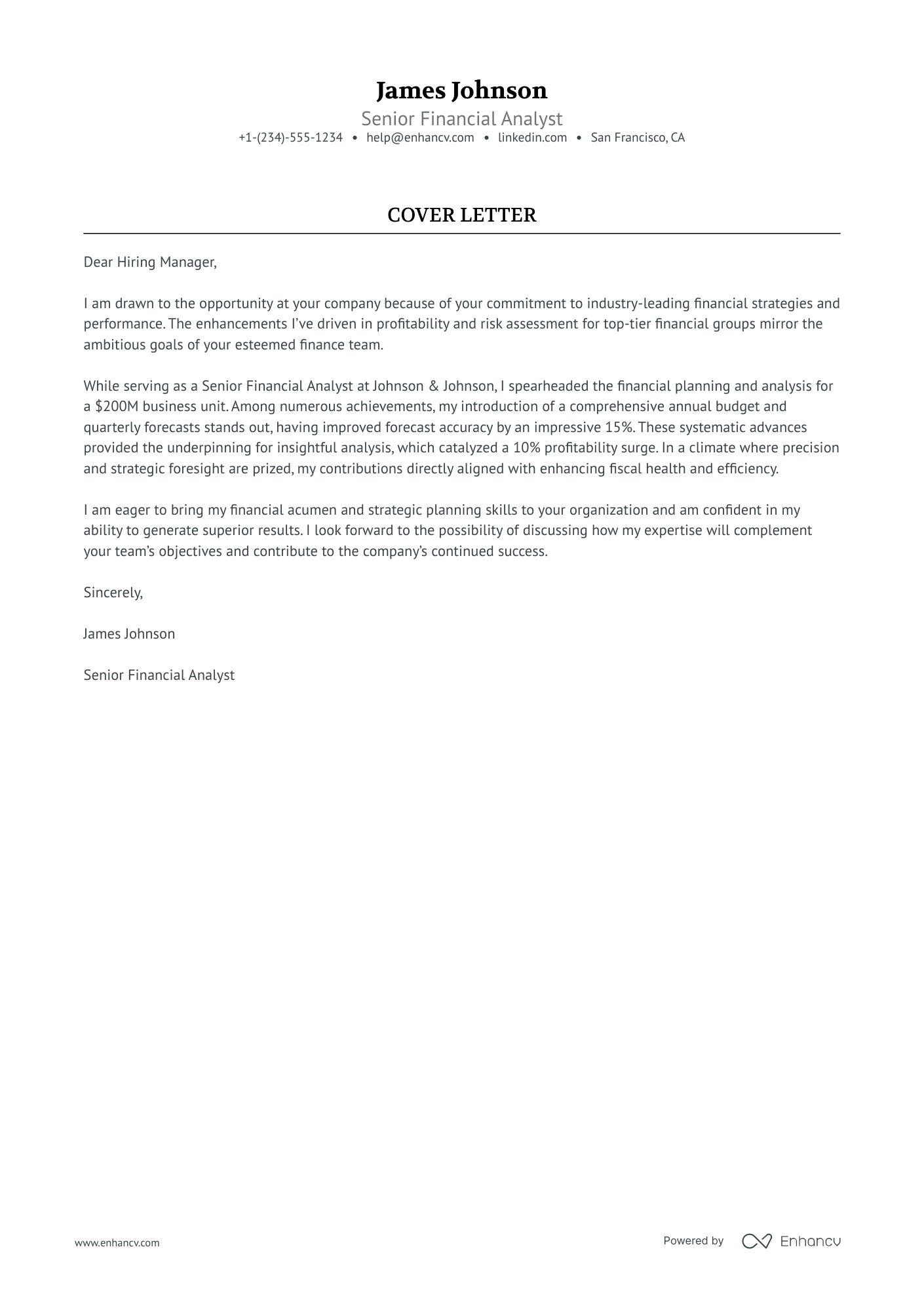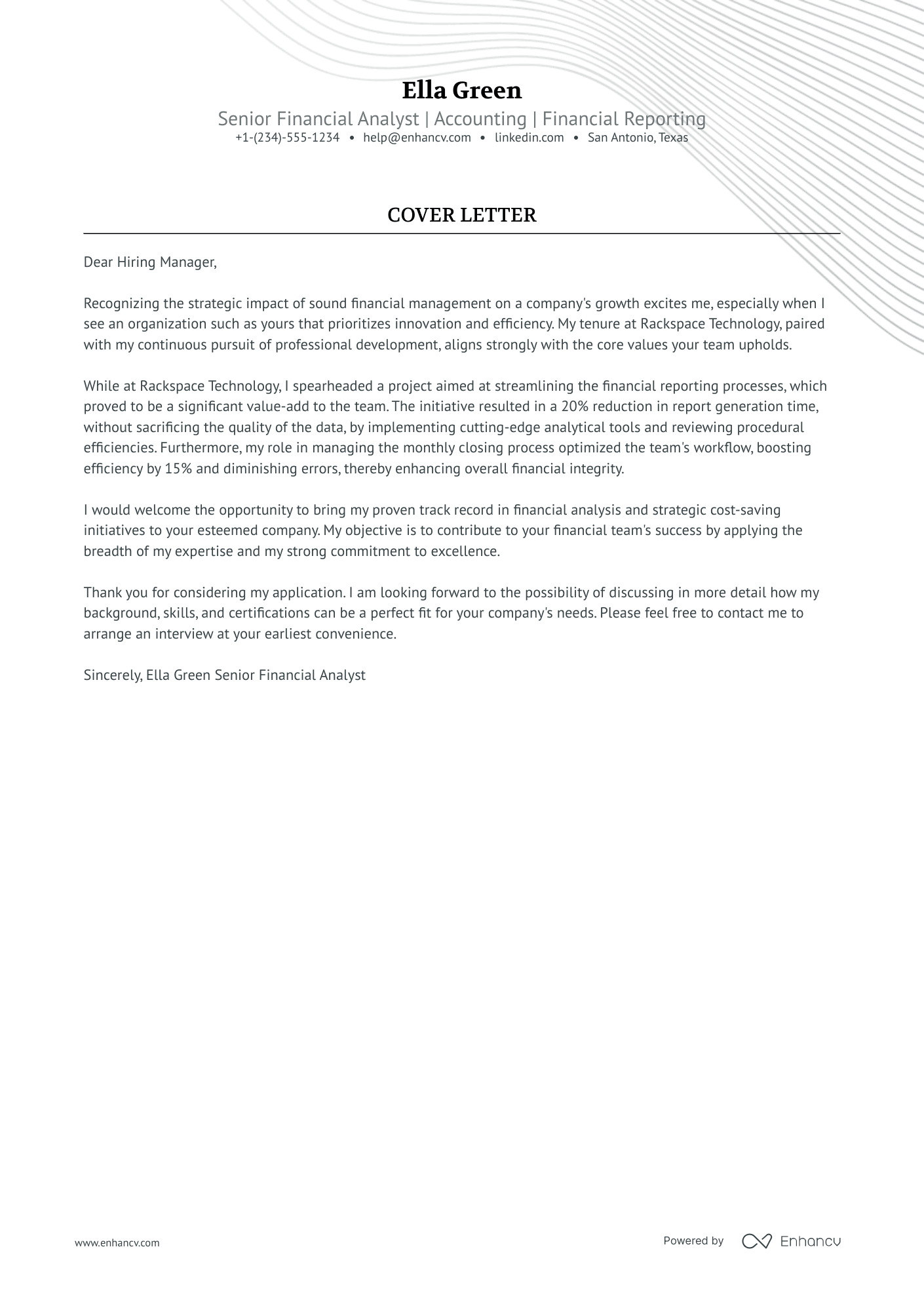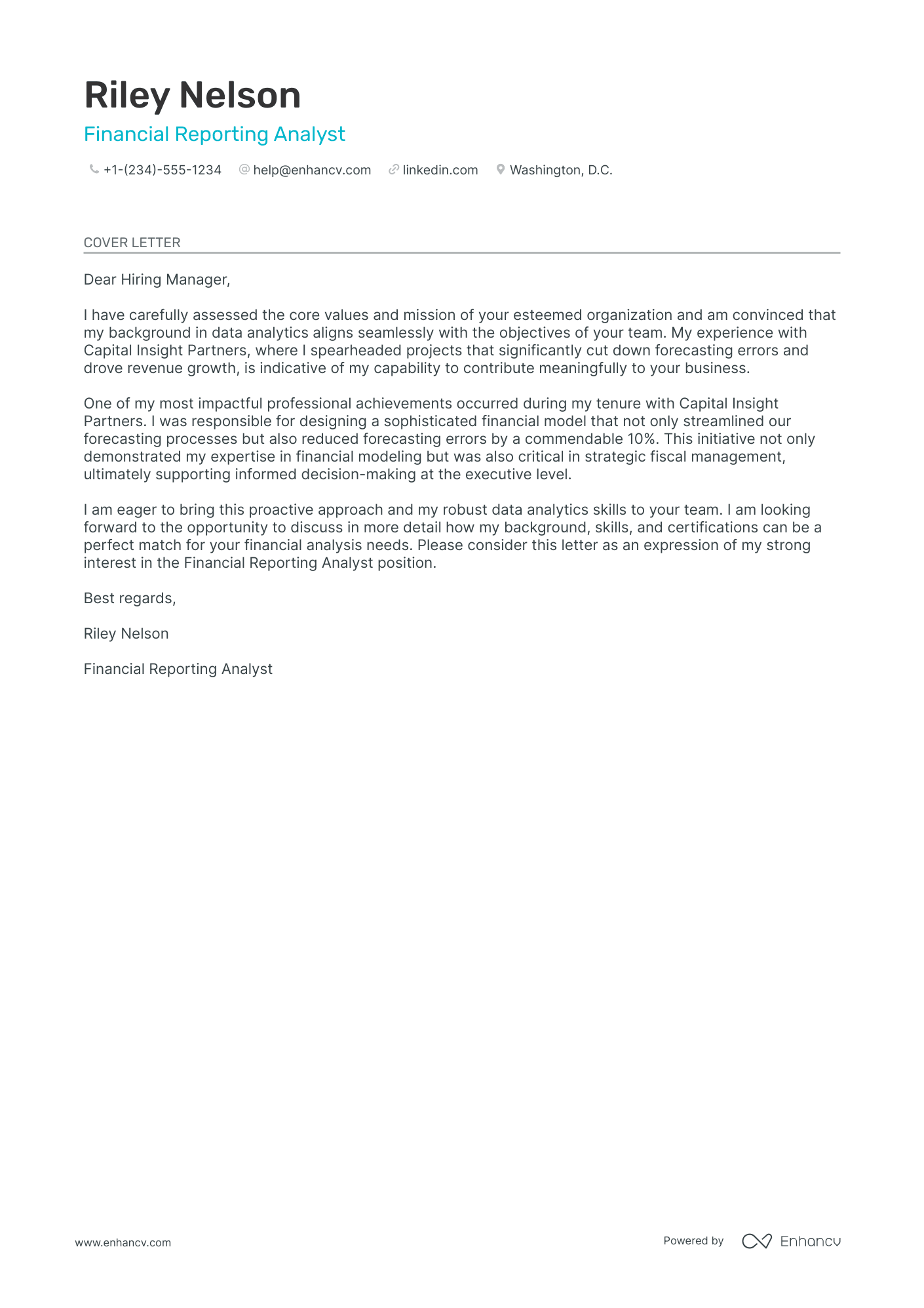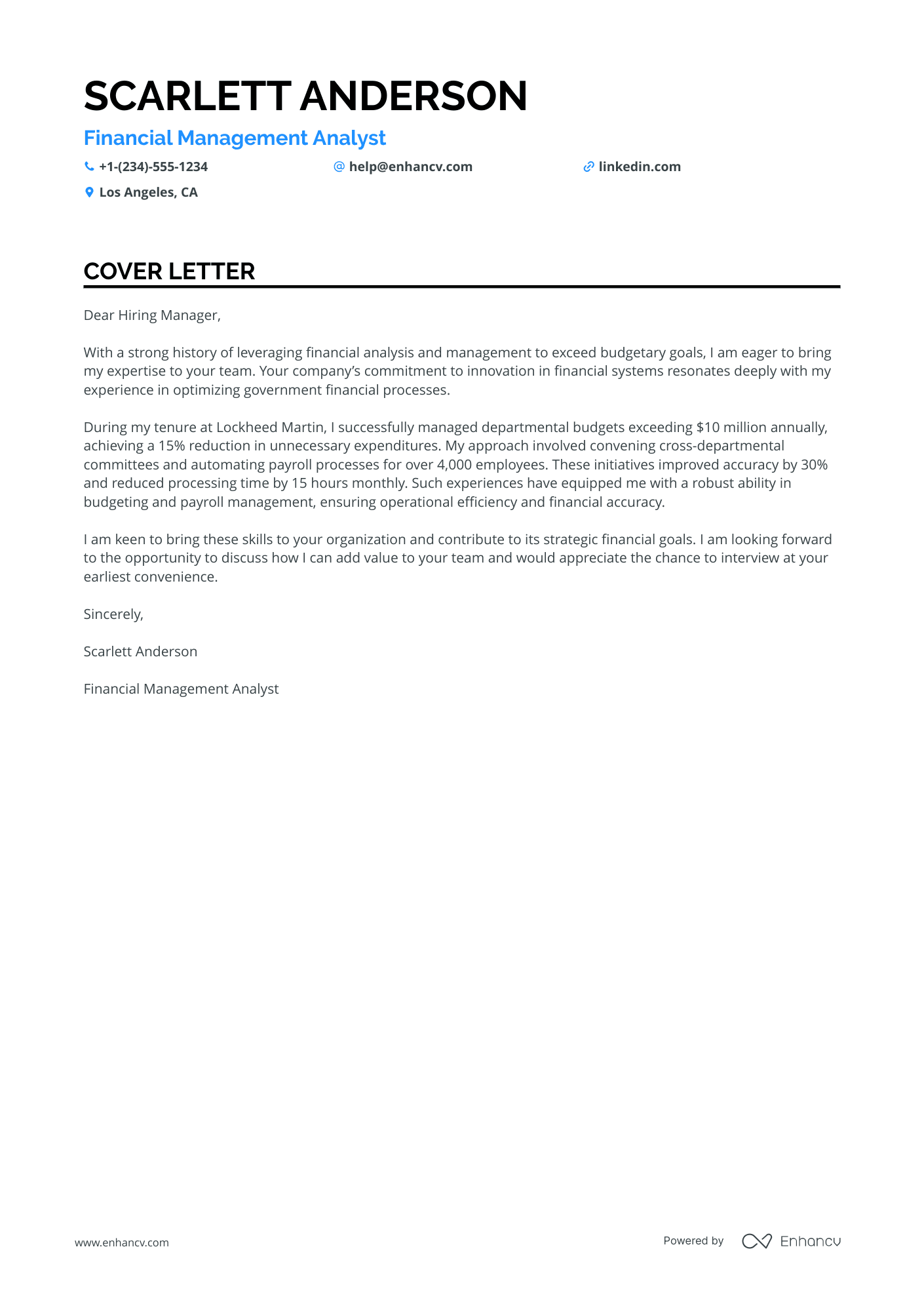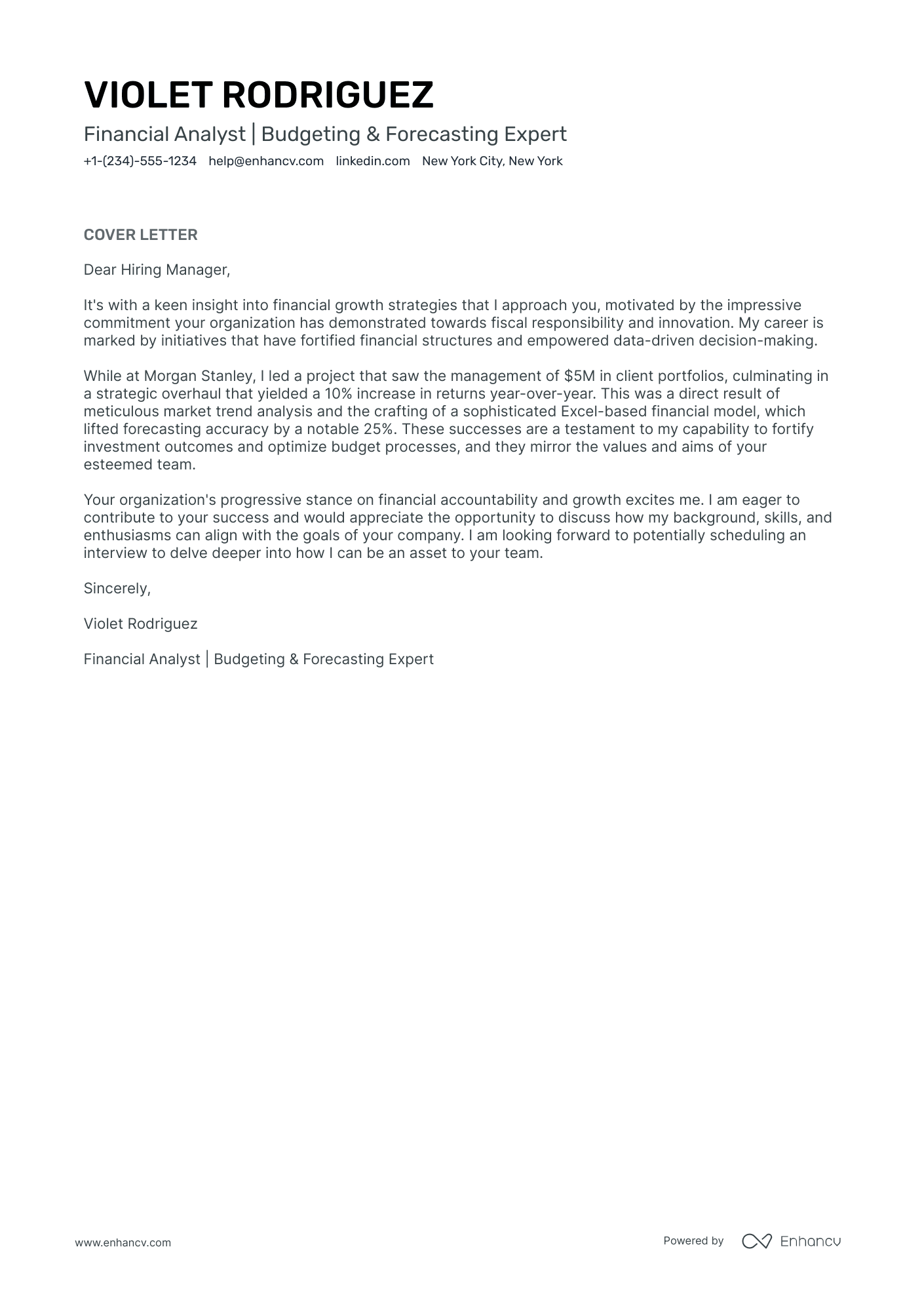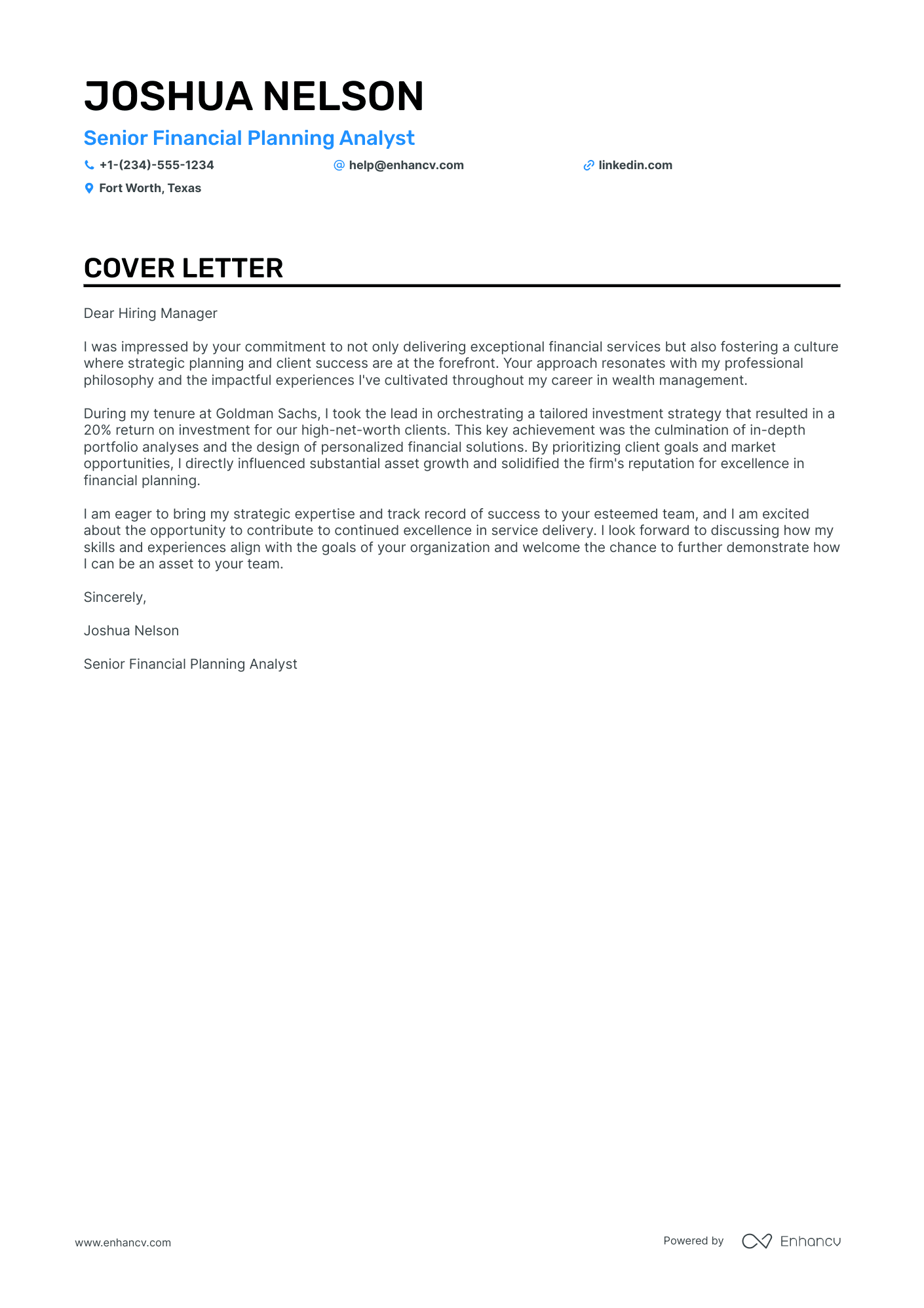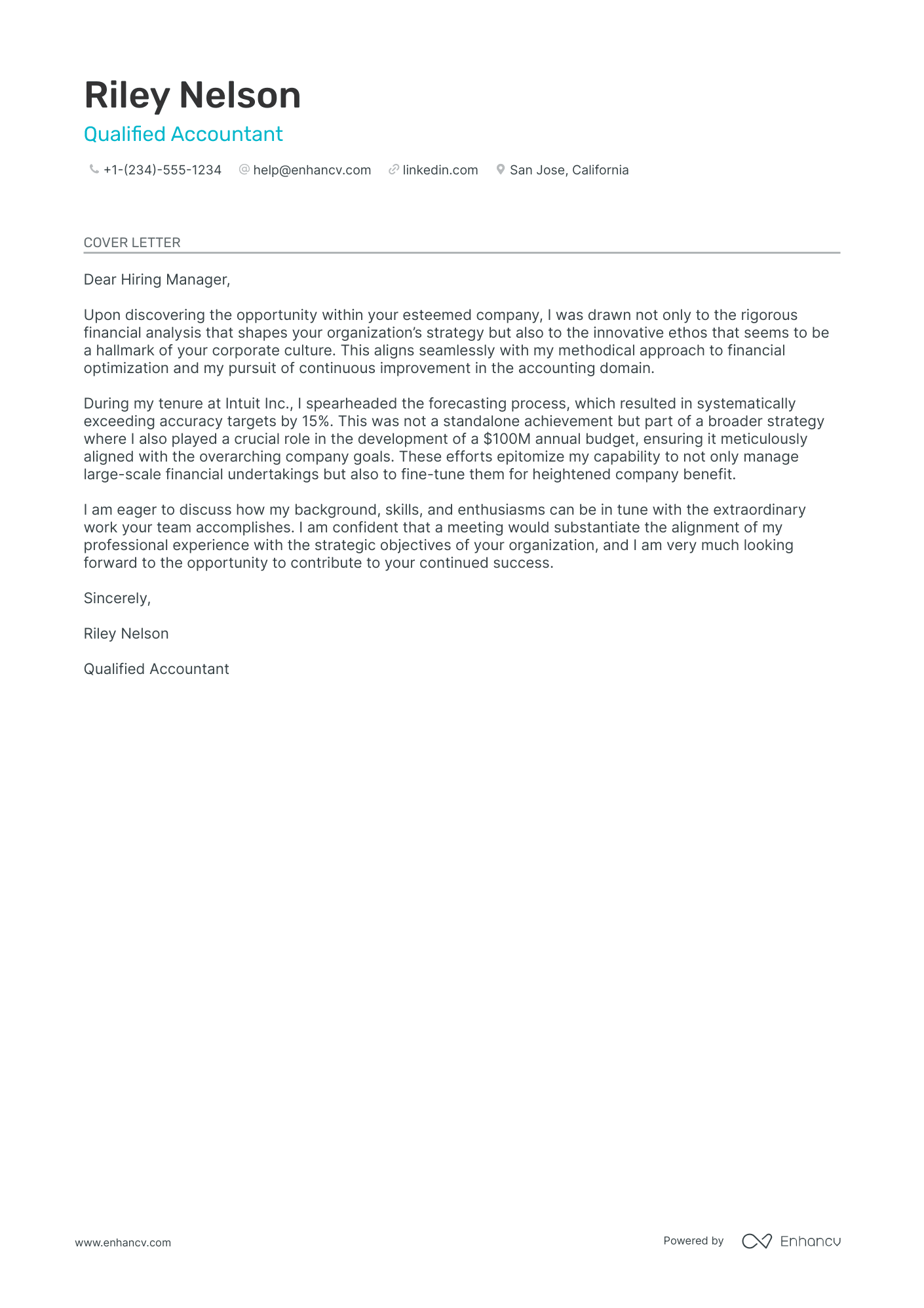Beginning to craft your financial analyst cover letter can be daunting, especially when you're deep in the job application process and realize it's a pivotal requirement. It's not about echoing your resume; your cover letter is your chance to shine by showcasing a standout professional triumph. Formal yet fresh, ditch the clichés and keep it concise to one page. Let's take a step-by-step approach to narrate your success story and grab that recruiter's attention.
- Step your best foot forward in the financial analyst cover letter introduction;
- Be inspired by other professionals' certified cover letters;
- Structure your financial analyst cover letter to feature what matters most;
- Close off your financial analyst cover letter to make a memorable impression on recruiters.
But where to start writing? Upload your resume into Enhancv's AI, which will prepare your financial analyst cover letter (all you need to do is personalize it, and you'll be good to go).
If the financial analyst isn't exactly the one you're looking for we have a plethora of cover letter examples for jobs like this one:
- Financial Analyst resume guide and example
- General Ledger Accounting cover letter example
- Finance Officer cover letter example
- Actuary cover letter example
- Accounts Payable Clerk cover letter example
- Deloitte cover letter example
- Corporate Banking cover letter example
- Senior Financial Analyst cover letter example
- Treasury Analyst cover letter example
- Payroll Admin cover letter example
- Financial Accounting cover letter example
Drop your resume here or choose a file.
PDF & DOCX only. Max 2MB file size.
Financial analyst cover letter example
James Johnson
New York
+1-(234)-555-1234
help@enhancv.com
- Relevant Experience: Detailing the specific experience at a notable company such as Wells Fargo, immediately establishes credibility and shows the candidate's capability in handling significant financial responsibilities.
- Quantifiable Achievements: Mentioning the precise achievement of improving the division's financial performance by 10% provides a measurable impact of the applicant's contributions, which is compelling evidence of past success.
- Transferable Skills: Emphasizing the development and implementation of financial models highlights critical thinking, analytical skills, and the ability to translate data into strategic decisions, which are highly valuable in a financial analyst role.
- Direct Call to Action: The candidate concludes with an invitation to discuss how their skills align with the company's goals, displaying confidence and a forward-thinking attitude that is key for roles involving strategic planning and finance.
What are the basics of the design or format of your financial analyst cover letter?
To start, here's a reminder for you: the Applicant Tracker System (or software that is used to assess candidate profiles), won't be reading your financial analyst cover letter.
Recruiters enjoy reading financial analyst cover letters with a standardized format that uses:
- the same font as the resume (e.g. modern ones like Raleway or Volkhov are prefered over the clichéd Times New Roman or Arial);
- single spacing to keep the content concise and organized (this is all ready for you in our cover letter templates);
- a one-inch margin to wrap around the text, like in our cover letter builder;
- PDF as a file format, as it allows your design (and visual element) to stay the same.
Finally, we can't go on without mentioning the key sections of your financial analyst cover letter.
In the top one-third, make sure to include a header (with your contact information, name, role, and date), a salutation, and an introduction.
Next, follows the heart and soul of your financial analyst cover letter or its body.
End your financial analyst cover letter with a closing paragraph and, if you wish, a signature.
Writing a cover letter can take time. Skip the hassle with our free cover letter generator and make one in seconds.
The top sections on a financial analyst cover letter
- Header: Include your full name, professional contact information, and date to ensure your cover letter looks professional and to make it easy for the recruiter to reach out to you.
- Greeting: Address the cover letter to the specific individual or hiring team by name; this shows you have done your homework and are serious about the position.
- Introduction: Briefly introduce yourself with a strong opening statement that highlights your relevant financial expertise and expresses your enthusiasm for the role.
- Body (Experience and Skills): Detail your financial qualifications by mentioning your education, professional certifications (like CFA or CPA), and relevant experience with financial modeling, analysis, and reporting to demonstrate your fit for the role.
- Closing and Call to Action: End with a strong closing statement, reiterating your interest in the position and inviting the recruiter to contact you for an interview to discuss how your finance skills can benefit the company.
Key qualities recruiters search for in a candidate’s cover letter
- Strong financial modeling skills: Essential for building abstract representations of real financial situations, which is a core part of financial analysis.
- Proficiency in data analysis software and tools: Critical for processing large datasets to derive insights, using tools like Excel, Tableau, SAS, or industry-specific platforms.
- Keen attention to detail: Vital for spotting errors that could lead to incorrect conclusions and ensuring the accuracy of financial reports and projections.
- Solid understanding of accounting principles: Necessary to interpret financial statements and understand the financial impact of business events.
- Excellent quantitative analytical abilities: Required for interpreting financial data, forecasting trends, and developing strategies based on complex financial information.
- Effective communication and presentation skills: Important for conveying complex financial concepts and findings to stakeholders who may not have a financial background.
Kick off your financial analyst cover letter: the salutation or greeting
When writing your financial analyst cover letter, remember that you're not writing for some complex AI or robot, but for actual human beings.
And recruiters, while on the lookout to understand your experience, would enjoy seeing a cover letter that is tailored to the role and addresses them. Personally.
So, if you haven't done so, invest some time in finding out who's the hiring manager for the role you're applying to. A good place to start would be LinkedIn and the corporate website.
Alternatively, you could also get in touch with the company to find out more information about the role and the name of the recruiter.
If you haven't met the hiring manager, yet, your financial analyst cover letter salutation should be on a last-name basis (e.g. "Dear Mr. Donaldson" or "Dear Ms. Estephan").
A good old, "Dear HR Professional" (or something along those lines) could work as your last resort if you're struggling to find out the recruiter's name.
List of salutations you can use
- Dear Hiring Manager,
- Dear [Company Name] Recruitment Team,
- Dear Mr./Ms. [Last Name],
- Dear [Department] Director,
- Dear [Job Title] Search Committee,
Get creative with your financial analyst cover letter introduction
Recruiters are going to assess plenty of candidate profiles for the role. Thus, anything you do to stand out will win you brownie points.
Use your financial analyst cover letter introduction to share something memorable about your experience.
But before you go down the rabbit hole of creativity and humor, align your message with the company culture.
For example, if you are applying for a role in some startup, use those first two sentences to tell a funny story (about your experience) to quickly connect with the recruiter.
Structuring your financial analyst cover letter body to add more value
You've hinted at your value as a professional (this may be your passion for the job or interest in the company) in your introduction.
Next, it's time to pan out the body or middle of your financial analyst cover letter.
When creating your resume, you've probably gone over the advert a million times to select the most relevant skills.
Well, it's time to repeat this activity. Or just copy and paste your previous list of job-crucial requirements.
Then, select one of your past accomplishments, which is relevant and would impress hiring managers.
Write between three and six paragraphs to focus on the value your professional achievement would bring to your potential, new organization.
Tell a story around your success that ultimately shows off your real value as a professional.
Time to wrap up your financial analyst cover letter
Writing the closing paragraph of your financial analyst cover letter is just as important as the salutation.
You have to make it personalized to the job advert and recruiter.
Experienced professionals advise candidates to end with a request or reminder for follow-up. Write that you're grateful for the opportunity, and, at the same time, hint that you're available for the next steps of the process.
Otherwise, you could also conclude your financial analyst cover letter by facing the future. How do you see yourself, as part of the team? In particular, how would you settle in your new role in the first six months to a year?
Addressing limited to no experience in the financial analyst cover letter
There's nothing to worry about if you lack professional experience.
Your financial analyst cover letter could bridge the gaps in your professional history by focusing on what matters most to recruiters, that's either:
- skills - focusing on transferable ones you've gained, thanks to your life experience (e.g. volunteering, certificates, etc.);
- achievements - select the most relevant and noteworthy one from your history (e.g. education, projects, etc.);
- motivation - describe how you envision your professional growth in the next up to five years, thanks to this opportunity.
Key takeaways
Your financial analyst cover letter is your best shot at standing out by showing your motivation and the unique skills you'd bring to the job:
- Chose no more than one achievement, which you'd be talking about in the body of your financial analyst cover letter, by focusing on skills and outcomes;
- Address recruiters with their first or last name, or "Dear Hiring Manager" in your financial analyst cover letter greeting;
- Introduce in no more than two sentences what makes your profile unique (perhaps it's your motivation, enthusiasm, or appreciation of the company you're applying for);
- Select the same font you have used in your resume (avoid Times New Roman and Arial, as most candidates tend to invest in them);
- Close your financial analyst cover letter with a promise of how you see yourself growing in the company and the benefits you'd bring about.
Financial Analyst cover letter examples
By Experience
Junior Financial Analyst
Senior Financial Analyst
Financial Analyst Intern
By Role
Corporate Financial Analyst
Entry Level Financial Analyst
Financial Management Analyst
Financial Planning Analyst
Financial Reporting Analyst
Financial Risk Analyst
Chartered Financial Analyst
Quality Assurance Financial Analyst
Financial Analyst Manager
- Highlighting Relevant Experience: The letter emphasizes the candidate's experience in managing substantial departmental budgets and achieving cost reductions, which is crucial for a Financial Management Analyst role.
- Quantifying Achievements: The inclusion of specific figures, such as a 15% reduction in expenditures and a 30% improvement in accuracy, provides concrete evidence of the candidate's capabilities and successes.
- Mentioning Technical Skills: The reference to automating payroll processes demonstrates the candidate's technical proficiency, a valuable skill for streamlining financial operations.
- Aligning With Company Values: The letter aligns the candidate's previous experience with the company's mission of innovation in financial systems, showing a clear understanding of the organization's goals.

